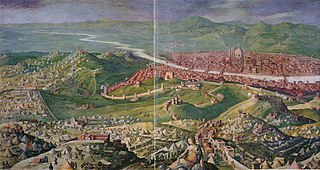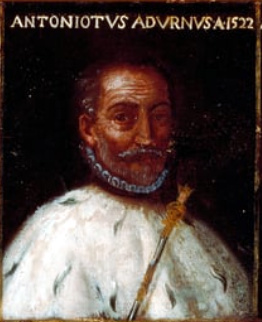| |||||
| Decades: | |||||
|---|---|---|---|---|---|
| See also: | Other events of 1528 History of France • Timeline • Years | ||||
Events from the year 1528 in France
| |||||
| Decades: | |||||
|---|---|---|---|---|---|
| See also: | Other events of 1528 History of France • Timeline • Years | ||||
Events from the year 1528 in France


Year 1528 (MDXXVIII) was a leap year starting on Wednesday of the Julian calendar, there is also a Leap year starting on Sunday of the Gregorian calendar.
Year 1485 (MCDLXXXV) was a common year starting on Saturday of the Julian calendar.

Francis I was King of France from 1515 until his death in 1547. He was the son of Charles, Count of Angoulême, and Louise of Savoy. He succeeded his first cousin once removed and father-in-law Louis XII, who died without a legitimate son.

Odet de Foix, Vicomte de Lautrec was a French military leader. As Marshal of France, he commanded the campaign to conquer Naples, but died from the bubonic plague in 1528.

The Republic of Genoa was a medieval and early modern maritime republic from the years 1099 to 1797 in Liguria on the northwestern Italian coast. During the Late Middle Ages, it was a major commercial power in both the Mediterranean and Black Sea. Between the 16th and 17th centuries, it was one of the major financial centres in Europe.

The War of the League of Cognac (1526–30) was fought between the Habsburg dominions of Charles V—primarily the Holy Roman Empire and Spain—and the League of Cognac, an alliance including the Kingdom of France, Pope Clement VII, the Republic of Venice, the Kingdom of England, the Duchy of Milan, and the Republic of Florence.

The Treaty of Cambrai, also known as the Paz de las Damas or Paix des Dames, was an agreement made on 3 August 1529 that ended the French involvement in the War of the League of Cognac between the French king Francis I and the Spanish Habsburg emperor Charles V. The treaty temporarily confirmed Spanish (Habsburg) hegemony in the Duchy of Milan and in Southern Italy.

Pedro Navarro, Count of Oliveto was a Navarrese military engineer and general who participated in the War of the League of Cambrai. At the Battle of Ravenna in 1512 he commanded the Spanish and Papal infantry, but was captured by the French. In the service of Francis I of France, he would supervise the French crossing of the Alps before the Battle of Novara in 1513.

The Black Bands, sometimes referred to as the Black Bands of Giovanni, was a company of Italian mercenaries formed and commanded by Giovanni de' Medici during the Italian Wars; their name came from their black mourning colours for the death of Pope Leo X. Composed primarily of arquebusiers—including Europe's first mounted arquebusiers—the company was, by the Italian War of 1521, considered to be the finest Italian troops available. Initially in the service of Charles de Lannoy and the Pope, the company fought at Bicocca in 1522 and the Sesia in 1523. A pay dispute led to it transferring its allegiance to Francis I of France; it took part in the Battle of Pavia under the command of Richard de la Pole, known as the "White Rose". In addition to the Italian units, German mercenaries in service of Francis I were called the "German black bands".

Teodoro Trivulzio (1458–1531) was an Italian condottiero and marshal of France.

Antoniotto II Adorno was Doge of the Republic of Genoa from 1522 to 1527. Adorno was the last of the Genoese doges elected for life.
The Battle of Landriano took place on 21 June 1529, between the French army under Comte de Saint-Pol and the Imperial–Spanish army commanded by Don Antonio de Leyva, Duke of Terranova in the context of the War of the League of Cognac. The French army was destroyed and the battle's strategic result was that the struggle between Francis I of France and Charles V, Holy Roman Emperor for control of northern Italy was temporarily at an end.
Events from the year 1525 in France
Events from the year 1521 in France
Events from the year 1544 in France.
Events from the year 1547 in France
Events from the year 1485 in France

The siege of Naples was a siege of the Italian city of Naples in 1528 during the War of the League of Cognac.
Events from the year 1522 in France